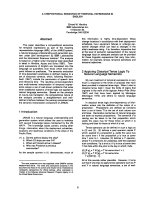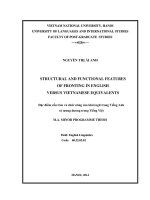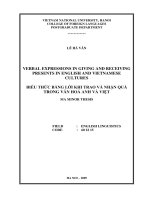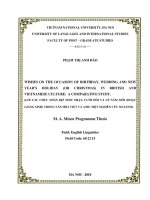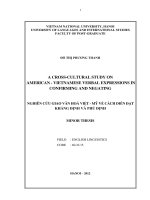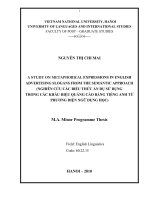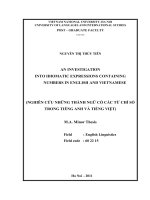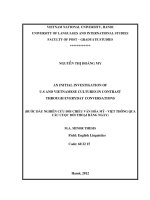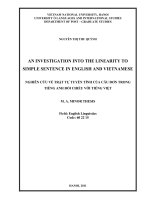verbal expressions in giving and receiving presents in english and vietnamese cultures = biểu thức bằng lời khi trao và nhận quà trong văn hoá anh và việt
Bạn đang xem bản rút gọn của tài liệu. Xem và tải ngay bản đầy đủ của tài liệu tại đây (1.12 MB, 63 trang )
VIETNAM NATIONAL UNIVERSITY, HANOI
COLLEGE OF FOREIGN LANGUAGES
POSTGRADUATE DEPARTMENT
************
LÊ HÀ VÂN
VERBAL EXPRESSIONS IN GIVING AND RECEIVING
PRESENTS IN ENGLISH AND VIETNAMESE
CULTURES
BIỂU THỨC BẰNG LỜI KHI TRAO VÀ NHẬN QUÀ
TRONG VĂN HOÁ ANH VÀ VIỆT
MA MINOR THESIS
FIELD : ENGLISH LINGUISTICS
CODE : 60 22 15
HA NOI – 2009
VIETNAM NATIONAL UNIVERSITY, HANOI
COLLEGE OF FOREIGN LANGUAGES
POSTGRADUATE DEPARTMENT
************
LÊ HÀ VÂN
VERBAL EXPRESSIONS IN GIVING AND RECEIVING
PRESENTS IN ENGLISH AND VIETNAMESE
CULTURES
BIỂU THỨC BẰNG LỜI KHI TRAO VÀ NHẬN QUÀ
TRONG VĂN HOÁ ANH VÀ VIỆT
MA MINOR THESIS
FIELD : ENGLISH LINGUISTICS
CODE : 60 22 15
SUPERVISOR : ASSOC. PROF. DR. NGUYỄN VĂN ĐỘ
HA NOI – 2009
iv
TABLE OF CONTENTS
* Acknowledgements ii
* Abstract iii
* Table of contents iv
* Abbreviations v
* List of Tables and Graphs vi
INTRODUCTION
1.1 Rationale 1
1.2 Aims of the study 2
1.3 Scope of the study 2
1.4 Methods of the study 3
DEVELOPMENT
CHAPTER 1: THEORETICAL BACKGROUND 4
1.1 The relationship between language & culture 4
1.2 Speech Acts 5
1.3 Verbal Expressions in giving and receiving presents 8
1.4 Linguistic Politeness 10
CHAPTER 2: THE STUDY 12
2.1 Hypotheses 12
2.2 Data collection 13
2.2.1 The Questionnaires 13
2.2.2 The Respondents 15
2.3 Data analysis 16
CHAPTER 3: RESULTS AND DISCUSSIONS 40
3.1 Findings in Vietnamese 40
3.2 Findings in English 42
3.3 Similarities and Differences 44
3.4 Tentative explanations in terms of linguistic politeness 46
CONCLUSION 48
REFERENCES 49
APPENDICES I
v
ABBREVIATIONS
S : Speaker
H : Hearer
G : Giver
R : Recipient
FTA : Fact Threatening Act
FT : Face Threat
No : Number
% : Percent
vi
LIST OF TABLES AND GRAPHS
Table 1: Age group correlation between English and Vietnamese respondents 15
Table 2: Gender correlation between English and Vietnamese respondents 15
Table 3: Living area correlation between English and Vietnamese respondents 15
Table 4: Occupation correlation between English and Vietnamese respondents 16
Table 5: Strategies in giving presents on the occasion of birthday 16
Table 6: Strategies in giving presents on the occasion of wedding 21
Table 7: Strategies in giving presents on the occasion of house warming 25
Table 8: Strategies in receiving presents 32
Table 9: Rank of importance of social factors 39
Table 10: Rank of importance of social factors 40
1
INTRODUCTION
1.1 Rationale
It can not be denied that English has been used as an international language all over the
world; it is the most widely spoken language which is used in many fields such as economics,
trade, tourism, diplomacy, politics, and press. In Vietnam, as a result of the Open-door policy,
the number of people learning English for various purposes is on the rise. They study English
to communicate with people from other countries where English is used as a native, a second
or just a foreign language, to read English materials, or simply to pass the national secondary
school exams.
Although English has been taught in Vietnam for many years, not until recently has the
focus of improving linguistic competence for learners been on syntax, on lexical and
phonological components of the language. Many people still believe that being good at
English means being good at linguistic competence. Thus, cultural factors are paid little
attention to.
In our modern world, however, globalization is expanding; the need for interacting and
communicating across nations is indispensable. Successful communication requires not only
purely linguistic competence but also the knowledge of social norms, social values and
relations between individuals known as communicative competence. Communicative
competence presupposes ability to use the language correctly and appropriately. This
pragmatic competence is as crucial as linguistic competence. The lack of it may lead to
rudeness, misinterpretation, cultural shocks, and even communication breakdown.
It is clear that people who lack an awareness of socio-cultural conventions in the target
language may face unwanted communication breakdown in cross-cultural interaction. For
example, if a Vietnamese speaker gave a native speaker of English a gift and he/she only
received the response from the receiver as: “Thank you” or “Thank you so much”, the
Vietnamese speaker may feel a little bit disappointed because he/she expects a more emotional
2
and warmer response than just saying “Thank you”. Obviously, cultural differences here made
the communication process unsuccessful.
Hence, the knowledge about cross-cultural communication is really essential. On this
basis, this study is done to contribute an insight into a really fine social manner: Giving and
receiving presents. It helps Vietnamese learners of English to find out the best English verbal
expressions which are often used when giving and receiving presents in specific situations and
vice versa. As the result, similarities and differences between Vietnamese and English verbal
expressions in giving and receiving presents will be identified. With this study, the researcher
desires to seek a number of suitable and interesting verbal expressions when giving and
receiving presents in English and Vietnamese in some specific circumstances for avoiding, or
at least, reducing the threat of communication breakdown in giving and receiving presents
particularly in intercultural communication.
1.2 Aims of the study
This study aims to:
- Find out typical models of English and Vietnamese verbal expressions used when
giving and receiving presents in specific situations.
- Identify the similarities and differences of English and Vietnamese verbal expressions
when giving and receiving presents.
- Make tentative explanations for these similarities and differences in terms of linguistic
politeness.
1.3 Scope of the study
As mentioned above, the study mainly focuses on English and Vietnamese verbal
expressions used when giving and receiving presents on three occasions: birthday, wedding,
and house-warming party. Due to its small scale, only 25 Vietnamese and 25 English native
speakers were involved in this study. These respondents were asked to complete the
questionnaires with information about their verbal expressions used in the case of giving and
receiving presents in certain situations.
3
Conclusions are based on the analysis of the data collected from the questionnaires. Data
obtained from questionnaires about what English native speakers and Vietnamese people
might say in certain situations may not be always the same as what they actually say in the real
life.
Similarities and differences between the English and Vietnamese verbal expressions
when giving and receiving presents are also discussed. In this study, giving and receiving
presents simply are understood as a nice symbol of cultural behaviors in normal life
expressing deep emotion, concern, gratitude and attention to the Recipient, bringing joy to
both the giver and receiver, promoting goodwill, and developing a closer relationship. As the
result, some tentative explanations for these similarities and differences in terms of linguistic
politeness will be given in this study.
1.4 Methods of the study
In order to carry out this study with the aim of a cross-cultural research, the main method
used is the quantitative one. All the comments, evaluation and conclusions in this thesis are
mainly based on:
1. Survey questionnaires;
2. Statistics, description and the analysis of the collected data.
4
DEVELOPMENT
CHAPTER 1: THEORETICAL BACKGROUND
1.1 The relationship between language and culture
Up to now, there has been much research with tremendous attempts to describe
complicated and diversified relationships between language and culture. In spite of opinion
divergences, it is said that culture embraces language and language reflects the image of
culture.
According to Sapir (1921), “language is a purely human and non instinctive method of
communicating ideas, emotions and desire by means of voluntarily produced symbols.”
Language is a part of culture and a part of human behavior. Anna Wierzbicka (1992, p.371)
regards “Language as a mirror of culture and national character”. People can understand the
cultural characteristics of the nation through the language they use. Richard et all, (1992, p.94)
defines: “Culture is the total set of beliefs, attitudes, customs, behaviors, social habits of the
members of a particular society”. This definition not only helps us to understand what the
culture is, but also lists the components of culture. Obviously, culture is sort of knowledge,
which everyone must possess to function within a society. Beliefs, attitudes, customs,
behaviors and social habits are not innate or born naturally, but they are learnt through the
socialization process in which you grow up a full member of a society. That is the reason why
culture does not belong to any single person but to all people.
It is often held that the function of language is to express thought and to communicate
information. Language also fulfills many other tasks such as greeting people, conducting
religious service, etc. Krech (1962) explained the major functions of language from the three
following aspects:
1) Language is the primary vehicle of communication;
2) Language reflects both the personality of the individual and the culture of his history.
In turn, it helps shape both personality and culture;
5
3) Language makes possible the growth and transmission of culture, the continuity of
societies, and the effective functioning and control of social group.
For many people, language is not just the medium of culture but also is a part of culture.
It is quite common for immigrants to a new country to retain their old customs and to speak
their first language amid fellow immigrants, even if all presents are comfortable in their new
language. This occurs because the immigrants are eager to preserve their own heritage, which
includes not only customs and traditions but also language. This is also seen in many Jewish
communities, especially in older members: Yiddish is commonly spoken because it is seen as
a part of Jewish culture.
It is obvious that language plays a paramount role in developing, elaborating and
transmitting culture and language, enabling us to store meanings and experience to facilitate
communication.
Language and culture are so closely related that the correct understanding of the
relationship between the two is vital in cross-cultural communication. Children learning their
native language are learning their own culture; learning a second language also involves
learning a second culture to varying degrees. On the other hand, language is influenced and
shaped by culture. It reflects culture. Cultural differences are the most serious areas causing
misunderstanding, unpleasantness and even conflict in cross-cultural communication.
1.2 Speech Acts
The theory of speech acts has long been studied. It was first formulated by the
philosopher John Austin in a series of lectures which are now collected into a short book
called How to do Things with Words (Austin, 1962). These ideas were then further developed
by other scholars such as Searle (1969, 1975), Labov and Fanshel (1977), Bach and Harnish
(1979), Edmondson (1981), Recanati (1987), Allan (1994) and so on.
Making a statement may be the paradigmatic use of language, but there are all sorts of
other things we can do with words. We can make requests, ask questions, give orders, make
promises, give thanks, offer apologies, and so on. Moreover, almost any speech act is really
the performance of several acts at once, distinguished by different aspects of the speaker's
intention: there is the act of saying something, what one does in saying it, such as requesting
6
or promising, and how one is trying to affect one's audience.
The theory of speech acts is partly taxonomic and partly explanatory. It must
systematically classify types of speech acts and the ways in which they can succeed or fail. It
must reckon with the fact that the relationship between the words being used and the force of
their utterance is often oblique.
For example, the sentence 'This is a pigpen' might be used non-literally to state that a
certain room is messy and filthy and, further, to demand indirectly that it be straightened out
and cleaned up. Even when this sentence is used literally and directly, say to describe a certain
area of a barnyard, the content of its utterance is not fully determined by its linguistic meaning
in particular, the meaning of the word 'this' does not determine which area is being referred to.
A major task for the theory of speech acts is to account for how speakers can succeed in what
they do despite the various ways in which linguistic meaning underdetermines use.
Austin identifies three distinct levels of action beyond the act of utterance itself. He
distinguishes the act of saying something, what one does in saying it, and what one does by
saying it, and dubs these the 'locutionary', the 'illocutionary' and the 'perlocutionary' act,
respectively. Suppose, for example, that a bartender utters the words, 'The bar will be closed
in five minutes,' reported by means of direct quotation. He is thereby performing the
locutionary act of saying that the bar (i.e., the one he is tending) will be closed in five minutes
(from the time of utterance), and what is said is reported by indirect quotation (notice that
what the bartender is saying, the content of his locutionary act, is not fully determined by the
words he is using, for they do not specify the bar in question or the time of the utterance). In
saying this, the bartender is performing the illocutionary act of informing the patrons of the
bar's imminent closing and perhaps also the act of urging them to order a last drink. Whereas
the upshot of these illocutionary acts understands on the part of the audience, perlocutionary
acts are performed with the intention of producing a further effect. The bartender intends to be
performing the perlocutionary acts of causing the patrons to believe that the bar is about to
close and of getting them to want and to order one last drink. He is performing all these speech
acts, at all three levels, just by uttering certain words.
7
Based on Austin‟s speech act theory, Yule (1996, p.55) presents a table showing the
speech acts classification as below:
Speech act classification
Speech act type
Direction of fit
S= Speaker; X= Situation
Declaratives
Word change the world
S causes X
Representatives
Make words fit the world
S believes X
Expressives
Make words fit the world
S feels X
Directives
Make the world fit words
S wants X
Commissives
Make the world fit words
S intends X
As we can see, Yule distinguishes types of speech acts which can be made on the basic of
structure. According to him, three structural forms (Declarative, Interrogative, and
Imperative) and the three general communicative functions (Statement, Question and
Command/Request) can be combined with each other to create two types of speech acts
namely Direct and Indirect speech acts. He argues, “Whenever there is a direct relationship
between a structure and a function, we have a direct speech act. Whenever there is an indirect
relationship between a structure and a function, we have an indirect speech act” (Yule, 1996,
p.55). In uttering "Turn on the fan, please", the speaker (S) has directly requested the hearer
(H) to turn on the fan. The syntactic structure of this utterance indicates a straightforward
request in English. But the same request can be made in a more tacit, indirect manner to
achieve the same result. S may say something like "It is very hot in here". Or let us have a
look at another example in asking someone blocking the TV screen to move: "Move out of the
way". This is a direct speech. There are different structures can be used to accomplish the
same basic structure above but now they are functioning as indirect speeches.
a. This is a really exciting program.
b. You'd made a better door than a window.
c. How about moving over just a teensy bit.
d. Would you mind moving just a bit?
8
e. Do you have to stand in front of the TV?
f. You are standing in front of the TV.
In summary, indirect speech acts are generally associated with greater politeness in
English than direct speech acts because politeness is one of characteristics of indirect speech
acts.
1.3 Verbal Expressions in Giving and Receiving Presents
Giving a gift/present is an ancient and universal way to express, among other things,
gratitude, appreciation, altruism and love (Saad & Gill, 2003). Presents/Gifts have been
defined as "something that is bestowed voluntarily and without compensation
(Dictionary.com, 2005). Anthropologists and psychologists have viewed gift behavior as a
product of an interaction between psychological mechanisms and the environment (Toby and
Cosmides, 1992).
Dr. Gary Chapman, in his book The Five Love Languages [Northfield Publishing, 1995],
identifies five different ways in which people communicate their love to one another. When
you understand and know your partner‟s love language, you can effectively communicate your
love in such a way that he/she feels loved.
One of the basic five love languages is receiving presents, a verbal expression of love and
appreciation. An unconditional gift says “I was thinking of you and thought you might like
this. I love you.”
Jeannette Haviland-Jones, a professor of psychology at Rutgers University studied the
scientific power of flowers and found that flowers create instant delight and happiness, and
induce powerful positive emotions. Upon receiving a gift of flowers, female study participants
responded with true smiles, showed improved episodic memory and reported positive moods
that lasted even three days later.
M.J. Ryan, award-winning author of Giving Thanks: The Gifts of Gratitude [Conari
Press, 2007], corroborates the findings and observations that gifts increase human connectivity
and bonding: “Gift recipients experience compelling connections with givers ”
9
Gift giving is not a new idea. Communities around the world mark religious festivals,
secular holidays and important dates with presents and sharing of food. Christmas, Hanukkah-
an eight-day Jewish festival of lights held in December, commemorating the rededication of
the Jewish Temple in Jerusalem in 165 BC after its desecration, Thanks Giving, Chinese New
Year, Birthdays, and Valentine‟s Day are just a few of such occasions where gift exchange
and a deepening of ties with friends and loved ones take place.
But why should the giving and receiving of presents be limited to particular occasions?
Some may resist the notion that gift giving is an expression of love, especially when they have
entrenched attitudes about money. For example they may believe that money should be saved
and not spent on buying presents. Adjusting these beliefs, they may come to see that
gifts/presents to be their partner‟s primary love language and the money is not spent on the gift
itself but on the deepening of their relationship.
Gift giving does not make someone a spendthrift any more than gift receiving makes a
person greedy. Of course, you may choose to splurge on a pair of tickets for a romantic
getaway to an exotic location, precious gemstone jewelry or a state-of-the-art technological
gadget.
Alternatively, you may choose for a cheaper but no less special gift of a romantic dinner
together, a bouquet of her favorite flowers or a favorite photo of the two of you blown up in a
photo frame. Perhaps you may prefer the personal touch of burning a compilation of love
songs onto a CD or writing a series of poems or prose that speaks volumes about your feelings
or hand making a special card.
Giving and receiving presents is a universal love language. Whatever present ideas you
may have, remember that they need to neither be expensive nor numerous; if your mate
resonates with this love language, a sincere present brings happiness and security to the
relationship. It is an effective way to improve one‟s emotional health and to show gratitude
and appreciation.
10
1.4 Linguistic Politeness
The concept of Politeness has been part of linguistic studies since the late 1970s but it was
the publication of Brown and Levinsons‟ famous Politeness book, in 1978 that established this
issue as one of the main areas of Pragmatics theory, a novelty that emphasized the importance
of this concept in human interaction (Sifianou, 1992). However, since in our times the
definition of politeness is „the attitude of being socially correct, being refined and having good
manners‟ (Oxford Dictionary 1981), then two issues emerge immediately: first that neither
speakers‟ linguistic behavior necessarily accounts for their real motivation, nor should we
assume that all languages share the same perceptions as far as concepts as „good manners‟ or
„social correctness‟ are concerned (Thomas, 1995; Sifianou, 1992). Scholars have nowadays
agreed on the fact that politeness is conceptualized differently and so, manifested differently in
each society, an argument supported by Sifianou (1992), who points out that „ despite
popular stereotypes, no nation may be objectively verified as more or less polite than any
other, but only polite in a different, culturally specific way‟.
Within the issue of politeness, the most respected theory appears to be, as
aforementioned, Brown and Levinson‟s. The basis of their theory is the concept of face, a term
referring to every individual‟s sense of self-image. This concept involves a positive and a
negative aspect:
Negative face: the want of every „competent adult member‟ that his actions be
unimpeded by others.
Positive face: the want of every member that his wants be desirable to at least some
others. (Brown & Levinson, 1978)
The concept of face leads to the hypothesis that certain illocutionary acts could be face-
threatening, an idea introduced once again by Brown and Levinson (1978). Face-threatening
acts (FTA), are liable to threaten or damage the Hearer‟s positive face, i.e. expressions of
disapproval/criticism, accusations, contradictions, interrupting, expressions of violent
emotions, etc., and threaten his/her negative face, i.e. orders, requests, reminding, offers,
11
promises, etc. Moreover, certain acts can also be face threatening to the Speaker‟s positive
face, such as expressing thanks, excuses, acceptance of offers/apologies, etc., as well as
his/her negative face, such as apologies, acceptance of compliments, confessions/admissions
of guilt or responsibility, etc. Thus, always according to Brown and Levinson‟s hypothesis, the
speaker should adopt certain strategies, in order to maintain his or her own face undamaged
and at the same time to minimize the possibility of affecting the positive or negative face of
the Hearer. If the Speaker decides to perform a FTA, then Brown and Levinson (1978) suggest
a framework that determines the choice of his/her strategy:
Circumstances determining choice of strategy:
Diagram 1: Possible strategies for doing FTAs (Adapted from Brown & Levinson, 1987, p.60-69)
As can be seen from the diagram above, in the context of the mutual vulnerability of face,
S has two options: She/he may seek to avoid the face-threatening act (Do not do the FTA) or
she/he may decide to “do the FTA”. If S decides to do the FTA, she/he can either go off
record, in which case there is more than one unambiguously attributable intention so that S
can not have committed him/herself to one particular intent, or S can go on record expressing
Do the FTA
on record
1. without redressive action, baldly
4. off record
with redressive action
2. positive politeness
3. negative politeness
5. Don’t do the FTA
Greater
Estimation of risk of
face loss
Lesser
12
his/her intention clearly and unambiguously. In the later case, S may express her/his intentions
without redressive action, i.e. badly on record, or S may choose to employ strategies to
minimize the face threat referred to as redressive action. In using negative politeness
strategies, such as minimizing, weakening, and avoiding, the speaker can acknowledge the
addressee‟s personal territory and personal freedom of action as negative politeness orients
toward the hearer‟s negative face, roughly the expression of restraint and deference. In using
positive politeness strategies, for example intensifying strategies, the speaker can show
recognition and appropriate validation of the addressee‟s self-image as positive orients toward
the hearer‟s positive face, roughly the expression of solidarity.
To sum up, politeness, in the light of Brown-Levinson‟s politeness theory, can then be
defined as a desire to protect self-images. A speaker must show awareness of the hearer‟s face
and self-image of her/his own in the particular cultures. In every day conversation with
different situations people are obligated to adjust the use of words to fit to occasion. English
native speakers frequently use politeness and politeness strategies when they communicate.
When they are with friends, they say things that are informal. When they are surrounded by
the strangers, they say in formal ways. General speaking, in both situations, people try to
avoid making the hearers feel embarrassed or uncomfortable.
CHAPTER 2: THE STUDY
The focus of this chapter is on the verbal expressions in giving and receiving presents in
English and Vietnamese. In fact, what to say when giving a present and how to respond when
receiving a present are culture-specific and depend on many factors such as the context of
interaction, S-H relative role relationship, gender and age, …etc. Arising from these factors, a
number of hypotheses are suggested for investigation. Apart from these factors, these
hypotheses are raised on the basic of typical models of verbal expressions as English native
speakers and Vietnamese people use when they give and receive presents.
2.1 Hypotheses
As hypotheses, my assumption is that:
13
1. Age is the most important factors in selecting verbal expressions in giving and
receiving presents in both English and Vietnamese.
2. Anglophone speakers favor short and simple utterances whereas the Vietnamese ones
prefer longer and more complex sentences.
3. Vietnamese speakers (VS) are likely to use the strategy “wishes” when giving presents
more often than English native speakers.
4. Both English native speakers and Vietnamese speakers prefer the strategy “thanking”
as receiving presents.
The situations are chosen to investigate are:
1. Birthday
2. Wedding
3. House-warming party
Among:
1. Close friends
2. Brothers/sisters
3. Employers
4. Employees
2.2 Data Collection
2.2.1 The Questionnaires
The instrument to collect data is the survey questionnaire that meets the aims of the
study. The survey questionnaire is designed in Vietnamese and English and delivered to
twenty five English informants and twenty five Vietnamese ones.
There are three parts in the survey questionnaire, each of which serves a particular
purpose of the thesis (the Vietnamese and the English survey questionnaires are attached in the
Appendices):
Part 1: This part is designed to obtain information about the informants who are asked to
do the questionnaire.
Part 2: The purpose of this part is to find out what the informants would say when they
give and receive presents on special occasions. Six situations are included in the questionnaire
14
and the informants are asked to answer the following questions:
- Situation 1: What would you say when you give a present/gift to the following
person on the occasion of his/ her birthday?
- Situation 2: What would you say when you give a gift/present to the following
person on the occasion of his/her wedding?
- Situation 3: What would you say when you give a gift/present to the following
person on the occasion of his/her house- warming?
- Situation 4: What would you say when you receive a gift/present from the following
person on the occasion of your birthday?
- Situation 5: What would you say when you receive a gift/present from the following
person on the occasion of your wedding?
- Situation 6: What would you say when you receive a gift/present from the following
person on the occasion of your house- warming?
In each situation, the informants were required to express verbally when they give and
receive a present from the following people:
- Their close friend
- Their brother/ sister
- Their employer
- Their employee
Part 3: In this part, social factors governing the verbal expressions when giving and
receiving presents are considered. The informants are suggested to answer the following
question:
Which factor(s) influence(s) your verbal expressions when you give and receive a gift/
present? (Please number in order of importance)
- Social status
- Age
- Gender
- Family relation
- Others
15
2.2.2 The Respondent
There are two groups of respondents in my study. The first group consists of twenty five
Vietnamese native speakers. The other group consists of twenty five English native speakers.
All of them come from different parts of England. The informants are differentiated according
to the factors of age, gender, occupation, and residential area where they have spent most of
their life.
a. Age
Among 50 informants, nine of them are under the age of 20, 19 are between the age of 20
and 30, 14 are in their thirties and 8 are in their forties. These data are presented in Table 1:
Age
<20
20-30
30-40
>40
Vietnamese
20%
44%
20%
16%
English
16%
32%
36%
16%
Table1: Age group correlation between English and Vietnamese respondents
b. Gender
The number of males and females participated in the survey is relatively equal. Nearly half
of them are men (24) and the other 26 are women.
Gender
Male
Female
Vietnamese
44%
56%
English
40%
60%
Table2: Gender correlation between English and Vietnamese respondents
c. Living area
Area
Rural
Urban
Vietnamese
40%
60%
English
44%
56%
Table 3: Living area correlation between English and Vietnamese respondents
As seen in the table above, the number of rural citizens who take part in the survey accounts
for over 40%. Nearly 60% for the informants are living in urban areas.
d. Occupation
16
Occupation
Social
Technical
Vietnamese
40%
60%
English
56%
44%
Table 4: Occupation correlation between English and Vietnamese respondents
In this survey data analysis, I divide occupations into two categories: the social
(lawyer, teacher, interpreter, writer, journalist, etc.) and the technical (IT engineer, architect,
construction engineer, etc.)
2.3 Data analysis
2.3.1 The communicative strategies in giving presents
In this section, verbal expressions are analysed in relation to the situation of giving
presents and the status of the respondents .
2.3.1.1 On the occasion of Birthday
The analysis of the data has shown that there are two major strategies used to give
presents on the occasion of birthday.
No
Communicative strategy
Vietnamese
Anglophone
1.
Wishes
90%
95.24%
2.
Direct offer
10%
4.76%
Table 5: Strategies in giving presents on the occasion of birthday
As we can see from the table, both English and Vietnamese native speakers use
“wishes” at the highest rate. However, from the survey questionnaire, some informants
employ both strategies for more effective conversation between the G and R.
a. Wishes
This strategy is the most frequently used by both English native speakers: 95.24% and
the Vietnamese: 90%. The Anglophone informants usually use wishes for special occasions,
especially birthday. English native speakers‟ wishes for birthday tend to be short and simple
with the often use of adjective “happy”, “best” or the verb “have” like:
- Happy birthday!
- Happy birthday, all the best.
- Have a great day.
17
- Happy birthday. Hope you a great day
Whereas, Vietnamese speakers prefer to use long utterance with the frequent use of the verb
“chúc” because Vietnamese people believe that the more wishes they get, the more likely they
become true.
- Chúc bạn sinh nhật vui vẻ. (Happy birthday to you)
- Em chúc chị sức khoẻ, hạnh phúc, may mắn và thành đạt (Wish you health, happiness,
luck and success.)
- Chúc bạn thêm tuổi mới ngày càng chín chắn và hạnh phúc (a new age full of
happiness and more mature to you)
It is interesting that some Vietnamese informants use foreign language for their wishes on the
occasion of birthday like: Happy birthday!, or Joyeux anniveraise! These phenomena are
considered as the result of global integration process in Vietnam.
b. Direct offer
Using this strategy, the G shows his/her directness without any hesitation when he
gives a birthday present. Surprisingly, direct offer is used by the Vietnamese more often than
by English native speakers (10% vs 4.76%) although the Anglophone are believed to be more
direct in conversations than the Vietnamese.
It can be easily seen that Vietnamese informants often use the verbs “tặng”, “mừng” in their
expressions of gift giving while English native speakers prefer to use the preposition “for” in
their utterances.
- Tặng anh/em quà sinh nhật. (This birthday gift is for you)
- Em có chút quà nhỏ mừng sinh nhật sếp. (I have a small present for your birthday)
- Ê, quà của mày này. (hey, this gift is for you)
- Ê, tặng mày này. (hey, it is your present)
- A lovely gift for you.
- Hey, I have got a gift for your birthday.
- This is for you, my dear friend.
As we can see from above, direct offer and wishes are employed by both native speakers of
English and Vietnamese. However, the use of these strategies is different from partner to
18
partner. It depends on the relationship between the G and the R.
1. Close friend
It can be seen from the graph that both English and Vietnamese informants use
“wishes” at high rate (92% for Vietnamese and 80% for English informants) when they give
their close friends birthday presents. This shows that to the close friends, the strategy “wishes”
is really popular among English and Vietnamese informants in the event of birthday gift
giving. Surprisingly, the number of English informants using the strategy “direct offer” is
much higher than the number of Vietnamese ones (20% vs 8%). This shows that English
native speakers tend to express their straightforwardness, their formality when the
communicative partner is their close friend.
2. Brother/sister
19
For family members of same rank like brother or sister, 100% of the Anglophone use
the strategy “wishes” when they give birthday gift and the number of Vietnamese informants
use this strategy is 92%.
It is interesting that the strategy “direct offer” is not commonly used in this situation with only
8% of Vietnamese informants while no one in the group of English informants employs this
strategy.
3. Employer
Like these above situation, the strategy „wishes” continually keeps showing its
20
dominant place at a very high rate: 100% for English informants and 84% for Vietnamese
ones. It seems that wishes are the first choice for the Anglophone in birthday gift giving.
For people with higher positions such as boss, employer or supervisor, Vietnamese informant
still use the strategy “direct offer” when they give birthday presents with the number of 16%.
This may be opposite to what we expect before the research that Vietnamese people are
always aware of their social status before the ones who are at high rank, and therefore, they
tend to limit using direct utterances when they give presents to their employer.
4. Employee
For employee, the use of the strategy “wishes” is still dominant with 100% of English
informants employing this strategy compared with 92% of Vietnamese ones. Only 8% of
Vietnamese informant s use the strategy “direct offer” in giving presents to people who are of
lower social status.
In our observation, from the survey questionnaire, we can easily see that the strategy “wishes”
keeps its dominant position on the occasion of birthday by both English and Vietnamese
informants to all of their communicative partners. This shows birthday is a special occasion
for the Anglophone and Vietnamese associate their wishes with their lovely presents.
2.3.1.2 On the occasion of wedding
For wedding, the strategies “wishes” and “direct offer” are employed by both English
and Vietnamese informants.
